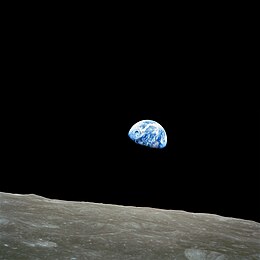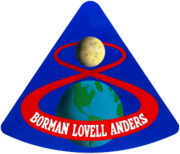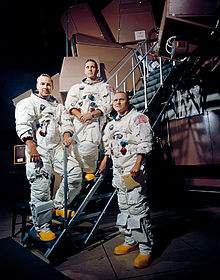
Back Apollo 8 Afrikaans Apollo 8 AN أبولو 8 Arabic Apollon 8 Azerbaijani Аполо 8 Bulgarian অ্যাপোলো ৮ Bengali/Bangla Apollo 8 Catalan ئەپۆلۆ ٨ CKB Apollo 8 Czech Apollo 8 Welsh
 | |
| Mission type | Crewed lunar orbital CSM flight (C') |
|---|---|
| Operator | NASA |
| COSPAR ID | 1968-118A |
| SATCAT no. | 3626[4] |
| Mission duration | 6 days, 3 hours, 42 seconds[5] |
| Spacecraft properties | |
| Spacecraft |
|
| Manufacturer | North American Rockwell |
| Launch mass | |
| Landing mass | 4,979 kilograms (10,977 lb) |
| Crew | |
| Crew size | 3 |
| Members | |
| Callsign | Apollo 8 |
| Start of mission | |
| Launch date | December 21, 1968, 12:51:00 UTC[9] |
| Rocket | Saturn V SA-503[n 1] |
| Launch site | Kennedy LC-39A |
| End of mission | |
| Recovered by | USS Yorktown |
| Landing date | December 27, 1968, 15:51:42 UTC[10] |
| Landing site | North Pacific Ocean 8°8′N 165°1′W / 8.133°N 165.017°W[10] |
| Orbital parameters | |
| Perigee altitude | 184.40 kilometers (99.57 nmi) |
| Apogee altitude | 185.18 kilometers (99.99 nmi) |
| Inclination | 32.15 degrees |
| Period | 88.19 minutes |
| Epoch | December 21, 1968, ~13:02 UTC |
| Revolution no. | 2 |
| Lunar orbiter | |
| Spacecraft component | CSM |
| Orbital insertion | December 24, 1968, 9:59:20 UTC[11] |
| Orbital departure | December 25, 1968, 6:10:17 UTC[10] |
| Orbits | 10 |
| Orbital parameters | |
| Periselene altitude | 110.6 kilometers (59.7 nmi) |
| Aposelene altitude | 112.4 kilometers (60.7 nmi) |
| Inclination | 12 degrees |

 Left to right: Lovell, Anders, Borman | |
Apollo 8 (December 21–27, 1968) was the first crewed spacecraft to leave Earth's gravitational sphere of influence, and the first human spaceflight to reach the Moon. The crew orbited the Moon ten times without landing and then returned to Earth.[1][2][3] The three astronauts—Frank Borman, James Lovell, and William Anders—were the first humans to see and photograph the far side of the Moon and an Earthrise.
Apollo 8 launched on December 21, 1968, and was the second crewed spaceflight mission flown in the United States Apollo space program (the first, Apollo 7, stayed in Earth orbit). Apollo 8 was the third flight and the first crewed launch of the Saturn V rocket. It was the first human spaceflight from the Kennedy Space Center, adjacent to Cape Kennedy Air Force Station in Florida.
Originally planned as the second crewed Apollo Lunar Module and command module test, to be flown in an elliptical medium Earth orbit in early 1969, the mission profile was changed in August 1968 to a more ambitious command-module-only lunar orbital flight to be flown in December, as the lunar module was not yet ready to make its first flight. Astronaut Jim McDivitt's crew, who were training to fly the first lunar module flight in low Earth orbit, became the crew for the Apollo 9 mission, and Borman's crew were moved to the Apollo 8 mission. This left Borman's crew with two to three months' less training and preparation time than originally planned, and replaced the planned lunar module training with translunar navigation training.
Apollo 8 took 68 hours to travel to the Moon. The crew orbited the Moon ten times over the course of twenty hours, during which they made a Christmas Eve television broadcast where they read the first ten verses from the Book of Genesis. At the time, the broadcast was the most watched TV program ever. Apollo 8's successful mission paved the way for Apollo 10 and, with Apollo 11 in July 1969, the fulfillment of U.S. president John F. Kennedy's goal of landing a man on the Moon before the end of the decade. The Apollo 8 astronauts returned to Earth on December 27, 1968, when their spacecraft splashed down in the northern Pacific Ocean. The crew members were named Time magazine's "Men of the Year" for 1968 upon their return.
- ^ a b Overbye, Dennis (December 21, 2018). "Apollo 8's Earthrise: The Shot Seen Round the World—Half a century ago today, a photograph from the moon helped humans rediscover Earth". The New York Times. Archived from the original on January 1, 2022. Retrieved December 24, 2018.
- ^ a b Boulton, Matthew Myer; Heithaus, Joseph (December 24, 2018). "We Are All Riders on the Same Planet—Seen from space 50 years ago, Earth appeared as a gift to preserve and cherish. What happened?". The New York Times. Archived from the original on January 1, 2022. Retrieved December 25, 2018.
- ^ a b Widmer, Ted (December 24, 2018). "What Did Plato Think the Earth Looked Like?—For millenniums, humans have tried to imagine the world in space. Fifty years ago, we finally saw it". The New York Times. Archived from the original on January 1, 2022. Retrieved December 25, 2018.
- ^ "Apollo 8". NASA Space Science Data Coordinated Archive. Retrieved November 21, 2019.
- ^ "Apollo 8". NASA. July 9, 2009. Retrieved November 25, 2018.
- ^ "Apollo 8 Press Kit" (PDF) (Press kit). NASA. December 15, 1968. pp. 33–34. Release No. 68-208. Archived (PDF) from the original on October 9, 2022. Retrieved June 28, 2013. The spacecraft mass at launch includes the CM and SM, but excludes the 4,000 kilograms (8,900 lb) Launch Escape System (LES), which was discarded before reaching Earth orbit.
- ^ "Pre-Launch Mission Operation Report No. M-932-68-08" (PDF) (Memorandum). NASA. December 17, 1968. p. 30. M-932-68-08. Archived (PDF) from the original on October 9, 2022. Retrieved February 12, 2019.
- ^ "Apollo 8 Mission Report" (PDF). NASA. February 1969. p. A-14. MSC-PA-R-69-1. Archived from the original (PDF) on March 2, 2013. Retrieved June 28, 2013. The mass for LTA-B was less than that of a flying LM, because it was essentially a boilerplate descent stage. A fully loaded, flight-ready LM, like the Eagle from Apollo 11, had a mass of 15,095 kilograms (33,278 lb), including propellants.
- ^ "Apollo 8". NASA Space Science Data Coordinated Archive. Retrieved January 9, 2023.
- ^ a b c "Apollo 8 Mission Report" (PDF). NASA. February 1969. p. 3-2. MSC-PA-R-69-1. Archived from the original (PDF) on December 22, 2016. Retrieved June 28, 2013.
- ^ "Apollo 8 Mission Report" (PDF). NASA. February 1969. p. 3-1. MSC-PA-R-69-1. Archived from the original (PDF) on December 22, 2016. Retrieved May 8, 2015.
Cite error: There are <ref group=n> tags on this page, but the references will not show without a {{reflist|group=n}} template (see the help page).